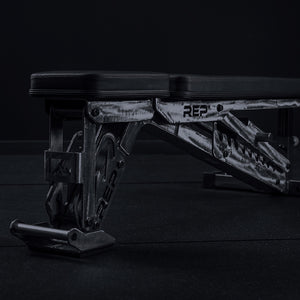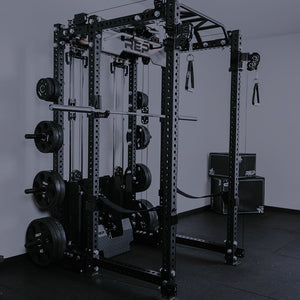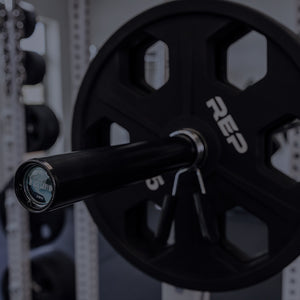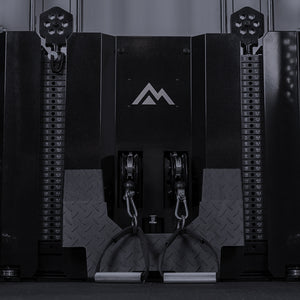
If you had to pick just one and only one attachment for your power rack, this might be the guy. It’s incredibly versatile, effective, great for lifters of all strength and experience levels, and an attachment you can add even more attachments onto.
We’re talking about a lat pulldown and low row attachment.
Now, if you have the budget for a more extensive cable attachment system, the benefits just skyrocket. But if you're on a budget and/or looking for one sure but simple way to elevate your home or commercial gym, you may be surprised by how much a lat pulldown and low row attachment can bring.
Luckily there are dozens of attachments compatible with every series of REP power racks, with new attachments constantly being developed – so you really don’t have to pick just one. But to give the lat and low row its moment in the spotlight, let’s dive a bit deeper into why you want to add this to your power rack.
Different Kinds of Lat and Low Row Attachments
REP makes a variety of different lat and low row options. And unlike J-cups or other attachments where you're adjusting height (and maybe using rack height magnets to make those adjustments faster and more precise), these cable pulley positions are set — so you can move from lat pulldowns to low rows in seconds.
- Selectorized Lat Pulldown and Low Row for 4000/5000 Series racks. Selectorized refers to the weight stacks attached to the pulley system (adjust them with a magnetic pin). This system features a 200lb weight stack with a 1:1 ratio, meaning 10lbs feels like 10lbs (by comparison, most functional trainers feature a 2:1 ratio, meaning 20lbs feels like 10lbs). The 1:1 ratio is ideal for slower, strength-focused moves. You can upgrade this weight stack to 300lbs.
- Plate-Loaded Lat Pulldown and Low Row for 4000/5000 Series racks. This pulley system is set up to use weight plates for resistance, rather than the built-on weight stack. This also has a 1:1 ratio. The weight horn can handle about 600lbs of iron plates. So while it's less convenient to change the weight and you need to buy (or already have) separate weight plates, if you need more than 300lbs of resistance, the plate-loaded option goes heavier. You can also convert your plate-loaded cable system into a selectorized one with a conversion kit.
- Lat Pulldown for 1000 Series racks. This simple, plate-loaded pulley system still packs plenty of exercise versatility and a 1:1 ratio. The weight horn capacity tops out at 450lbs – less than the 4000/5000 Series option.
What Exercises Can You Do on a Lat Pulldown and Low Row Attachment?
Various attachments open up different exercise options for your pulley system. Essentially, most slower, strength-focused cable exercises that use the highest or lowest attachment point can be performed on the Lat Pulldown and Low Row Attachment. It’s for much more than just the name suggests.
Here are a few ways to use it:
Lat Pulldowns
Lat pulldowns are a given with a lat pulldown attachment (duh), but you can switch this up with various handles: a standard 48” Solid Lat Bar, a Pro Series 48” Lat Bar, a neutral grip lat bar, a Triangle Row for neutral close grip pulldowns, and more.
Note: You may want a Leg Roller attachment to hold you down on the bench during these.

If you don’t have a Leg Roller or bench, you can still do standing, straight-arm lat pressdowns. Try them with a lat bar or straight bar.
Seated Rows

The other standard exercise of this attachment is a seated row, but you can mix it up with different handles, too. For example, try the Open Row for an extra deep range of motion, a straight lat bar for a wide-grip seated row, or a D-Handle for single-arm rows.
Curls

While this cable attachment doesn’t have the height adjustments of other on-rack cable attachments (like the Ares™ cable machine or Athena™ attachment), you can still get in your cable curls on the lower (seated row) cable point. Throw a Multi-Grip Curl Bar or Straight Bar on the carabiner and curl away.
Face Pulls
Do face pulls on the higher attachment while standing. Try these with a Tricep Rope.
Tricep Pushdowns
You can also work your tris on that higher attachment point. Using a straight bar, lat bar, or tricep rope, keep your elbows close to your body and push the bar down toward the ground. Or face away from the cable with your elbows at your ears and perform overhead tricep extensions.
Ab Crunches
You can blast your abs using the high attachment point paired with a tricep rope. Facing away from the machine, either standing or kneeling and with your chin tucked to your chest, curl your head/shoulders down toward your stomach. You can also perform these on a bench facing the cable.
Aimee Heckel, CPT, is a health and fitness journalist with over 20 years of experience. She set an all-time world-record deadlift in her division across all powerlifting federations at Mr. Olympia. In addition, she earned a national deadlift record and 18 Colorado state records. Heckel also has nine world records in grip sport, a pro card in natural figure bodybuilding, four first-place bodybuilding titles, and was named IPE Ms. Colorado Figure.

NEWSLETTER SIGNUP
Product launch information, promotions, blogs, and REP news.







